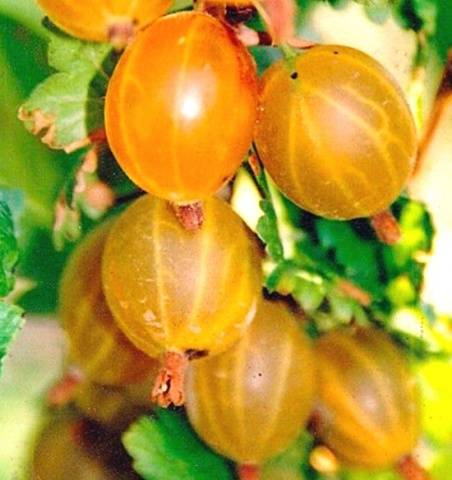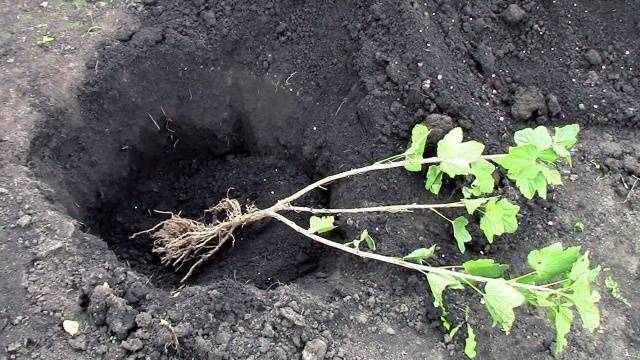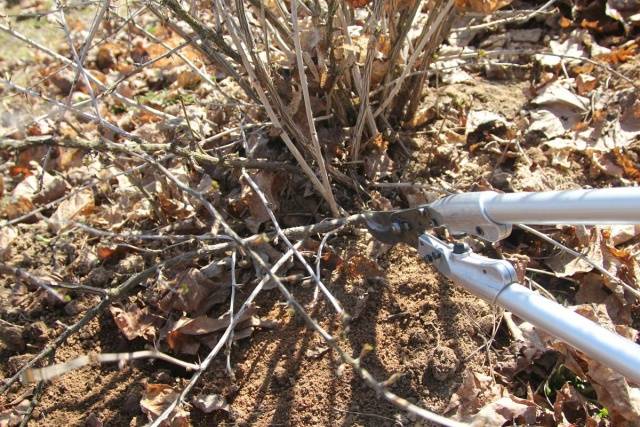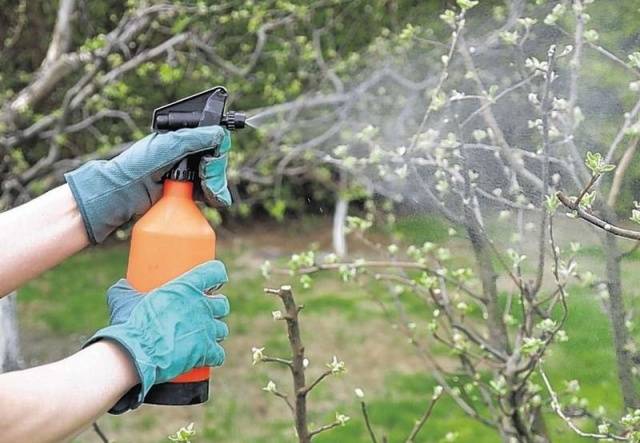Content
Yellow gooseberry varieties are distinguished by their unusual fruit color and good taste. Russian Yellow is a proven variety that is valued for its yield and unpretentiousness.
Breeding history of the variety
Gooseberry Russian yellow obtained at the All-Russian Research Institute of Horticulture named. I.V. Michurin, breeder K.D. Sergeeva. The gooseberry was bred by cloning the old Russian variety.
In 1963, the variety was sent for trials, according to the results of which in 1974 it was included in the State Register. Russian yellow is recommended for cultivation in the Ural and North-West regions.
Description of the bush and berries
Features of the variety Russian yellow:
- medium-sized, slightly spreading shrub;
- height from 1 to 2 m;
- straight branches;
- average number of thorns, most of which are located at the bottom of the shoots;
- green, leathery leaves with slightly curved tips.
Description of Russian yellow berries:
- large size;
- weight 5-7 g;
- oval shape;
- yellow pulp;
- transparent skin with a waxy coating.
Due to the dense skin, the berries hang on the bushes for a long time and do not crack. They have delicate flesh and sweet and sour taste.
Characteristics
The main characteristics of the Russian yellow variety:
Characteristic | Description |
Yield | 3.5-4 kg per bush |
Drought tolerance | high |
Winter hardiness | down to -28 ° С |
Disease and pest resistance | high |
Ripening period | middle |
Transportability | good |
Advantages and disadvantages
The main advantages of the Russian yellow variety:
- high commercial and taste qualities of berries;
- resistance to disease, drought and frost;
- good early maturity;
- universal use of fruits.
The disadvantages of the Russian yellow gooseberry include:
- the presence of sharp thorns;
- sour taste of berries.
Growing conditions
To successfully grow gooseberries, the following conditions are necessary:
- good natural light;
- lack of drafts;
- a site located on a hill or a gentle slope;
- light, fertile soil.
The yield and taste of the fruits depend on the illumination of the site. In the shade, the shrub develops slowly, and the fruits take a long time to gain sugar.
It is best to plant gooseberries in an elevated position or in the middle of a slope. Lowlands often accumulate moisture and cold air, which negatively affects the growth of crops.
Gooseberry prefers fertile soil: loam, sandstone or sandy soil. When planting, coarse sand and compost are introduced into clay soil.
Landing features
Gooseberries are planted in late autumn (September-October) or early spring (April-May). Works are carried out in dry and warm weather.
One- or two-year-old seedlings with multiple shoots and a healthy root system are suitable for planting. Planting material is purchased from nurseries or from trusted suppliers. It is not recommended to use seedlings with signs of decay, cracks and other defects.
Gooseberry planting order:
- The soil is dug under the gooseberry, cleaned of plant and other debris.
- Then a planting hole is dug with a diameter of 40 cm and a depth of 50 cm. The hole is left for 3-4 weeks for shrinkage. When carrying out work in the spring, it is better to prepare the pit in the fall.
- In clayey soil, sand or crushed stone is poured onto the bottom to create a drainage layer.10 kg of humus, 50 g of superphosphate and potassium sulfate are added to the fertile soil.
- The gooseberry is placed in a pit, and its roots are covered with earth.
- The soil is compacted, and the plant is watered abundantly with warm water.
After planting, the shoots are cut off and 5-6 buds are left on each. The soil is mulched with humus to retain moisture.
When planting several bushes, 1-1.5 m are left between them.If gooseberries are planted in rows, at least 3 m is kept between them.
Care rules
The growth and fruiting of the Russian yellow variety depends on care. The bush needs feeding and pruning. In colder regions, gooseberries are prepared for winter.
Support
A weakly spreading shrub of the Russian Yellow variety is able to grow without additional support. Its branches often bent to the ground under the weight of the berries. Due to the support, the process of harvesting and caring for the bush is simplified.
Therefore, it is recommended to install a support of wooden planks around the bush. You can use metal pipes and pull a wire between them.
Top dressing
When fertilizing the planting pit, the Russian yellow gooseberry does not need feeding for the next 3-4 years.
Adult bushes are fed according to the following scheme:
- in early spring;
- when flowering;
- 3 weeks after flowering.
For the first feeding, a natural solution is prepared, consisting of mullein or bird droppings. The bush is watered at the root after the snow melts before bud break. Fertilizer saturates the soil with nitrogen, which is necessary for the growth of shoots.
During the flowering period, a complex fertilizer based on phosphorus and potassium is prepared. For 10 l of water add 50 g of superphosphate and 30 g of potassium sulfate.
After the gooseberry bloom, potassium-phosphorus feeding is repeated. Fertilizers can be dry embedded in the soil around the bush.
Pruning bushes
Gooseberries are cut before or after sap flow. It is best to choose the fall period, as gooseberries wake up early after winter. Pruning is carried out annually.
Branches over 8 years old become unproductive, so they must be removed. Such shoots are identified by the dark brown color of the bark.
Reproduction
If you have a Russian yellow bush, you can get seedlings yourself. Gooseberry breeding methods:
- Cuttings. In the fall, the required number of shoots 20 cm long is cut off. The cuttings are kept in Fitosporin solution for 2 hours, then placed in the cellar for the winter. In February, gooseberries are rooted in containers filled with soil. When the seedlings have roots, they are transferred to a permanent place.
- Layers. In the spring, strong shoots are chosen from the gooseberry, which are lowered and fixed to the ground. In the middle part, the branches are spud and mulched with humus. In the fall, the layers are separated from the shrub and planted in a new place.
- By dividing the bush. When transplanting a gooseberry, its rhizome can be divided into several parts. Several healthy roots are left for each seedling. Places of cuts are sprinkled with charcoal.
Preparing for winter
The Russian yellow variety has high winter hardiness. In late autumn, plentiful sub-winter watering is performed, which helps to protect the gooseberries from freezing.
Young bushes need protection for the winter. Their shoots are covered with earth, a layer of humus 10 cm thick is poured on top. Spruce branches are tied to the branches. In winter, after snow falls, a snowdrift is thrown over the bush.
Pest and disease control
The main diseases that gooseberry are prone to are shown in the table:
Disease | Symptoms | Control measures | Prophylaxis |
Powdery mildew | A loose whitish bloom appears on the shoots. The plaque gradually darkens and covers the leaves, branches and fruits. | All affected parts are cut and burned. Gooseberries are treated with Bordeaux liquid, Topaz or Fundazol solutions. |
|
Anthracnose | White spots appear on the leaves, which grow and change color to brown. In the later stages, the leaves dry out and fall off. | Processing gooseberries with Bordeaux liquid. |
|
Rust | The appearance of orange spots on the leaves. Over time, the leaves curl and fall off. |
|
The most common gooseberry pests are listed in the table:
Pest | Signs of defeat | Control measures | Prophylaxis |
Aphid | Aphid larvae feed on gooseberry leaf juice. As a result, deformation of the leaves at the tops of the shoots occurs. | Plantings are sprayed with Fufanon or Aktara insecticides. |
|
Spider mite | The pest lives on the lower part of the leaves, gradually entangling them with cobwebs. The leaves begin to turn yellow and fall off. | Spraying gooseberries with an infusion of wormwood or tobacco. | Preventive treatments before flowering or after harvest. |
Sawfly caterpillars, moths, moths | They eat leaves, shoots and ovaries. | The caterpillars are harvested by hand. The shrub is sprayed with an infusion of wood ash or tobacco dust. |
|
Conclusion
Russian yellow gooseberry is able to withstand the harsh conditions of the Urals and Siberia. The variety is resistant to diseases and produces a stable high yield.
Testimonials













